“Charlie X”
Written by Gene Roddenberry and D.C. Fontana
Directed by Lawrence Dobkin
Season 1, Episode 7
Production episode 6149-08
Original air date: September 15, 1966
Stardate: 1533.6
Captain’s log. The Enterprise rendezvouses with the Antares, a ship that rescued a teenager named Charlie Evans, the sole survivor of a crashed ship as a child of three, who only had a few tapes to tell him how to live over the subsequent fourteen years. The Antares crew seems almost eager to get rid of him, declining even Kirk’s offer of supplies, booze, entertainment tapes, or anything, just running away quickly. (They also don’t talk at all until Charlie’s eyes go white for a second, and then they babble a mile a minute.)
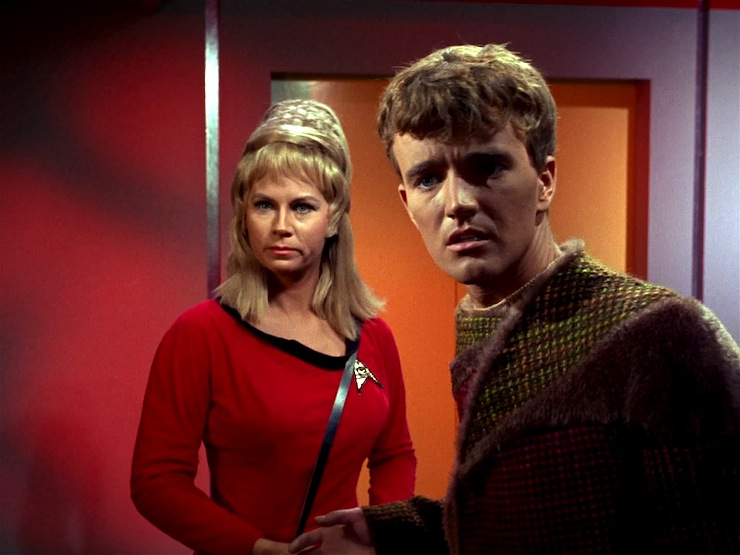
Charlie is confused by the sight of Rand—he’s never seen a woman before (apparently all twenty people on the Antares were male)—and after McCoy gives him a physical, Charlie asks if McCoy likes him. Apparently he didn’t think the people on the Antares liked him…
He wanders about the ship, observing people going about their duties. At one point, two guys agree to meet in the rec room later, followed by one slapping the other on the ass on his way out. Later, Charlie sees Rand, and gives her some of her favorite perfume—she has no idea where he got it, but he just says, “It’s a present.” He wants to talk, but she’s on duty. She gets him to agree to meet in the rec room later. Charlie, being a relatively new observer of human behavior, assumes that one acknowledges a meeting in the rec room with a slap on the ass, and does so to Rand. Rand fobs off explaining why, exactly, this is yucky on Kirk and McCoy and gets him to agree not to do it again.
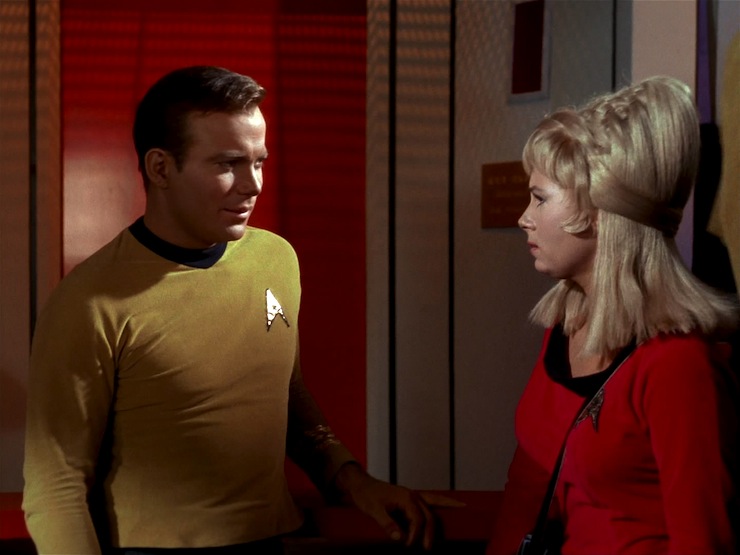
Charlie was found on Thasus, which prompts an argument between Spock and McCoy over the existence of Thasians, which is apparently a space urban legend of some moment. McCoy also insists that Kirk should be Charlie’s father figure, but Kirk would much rather fob that off on McCoy.
A bunch of people are hanging out in the rec room, including Spock (playing a Vulcan lyre), Uhura, and Rand. At Rand’s urging, Uhura starts singing a song about Spock. Charlie comes in and tries to get Rand’s attention with a card trick, but she shushes him so Uhura can finish her song. Again at Rand’s urging, Uhura does another verse, this one about Charlie. But then Charlie gets a look on his face and suddenly Uhura can’t sing and Spock’s lyre makes no noise. Charlie then starts doing card tricks, and nobody notices Uhura and Spock anymore.
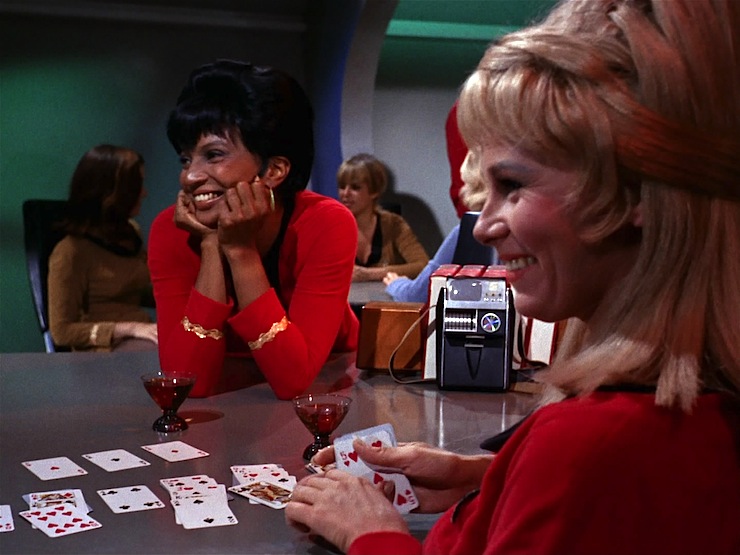
Charlie asks Kirk about why he shouldn’t smack Rand on the ass, and Kirk does a spectacularly horrible job of explaining. They’re interrupted by the bridge—Uhura has a call from the Antares. Captain Ramart says he has to warn somebody about something, but the transmission is cut off, and they soon realize that the ship has been destroyed. Charlie makes an offhand comment about the Antares being poorly constructed before Spock determines its destruction.
Kirk beats Spock at three-dimensional chess, and then Spock beats Charlie in about four moves. Charlie’s response is to make his eyes go white, after which the white pieces are all melted.
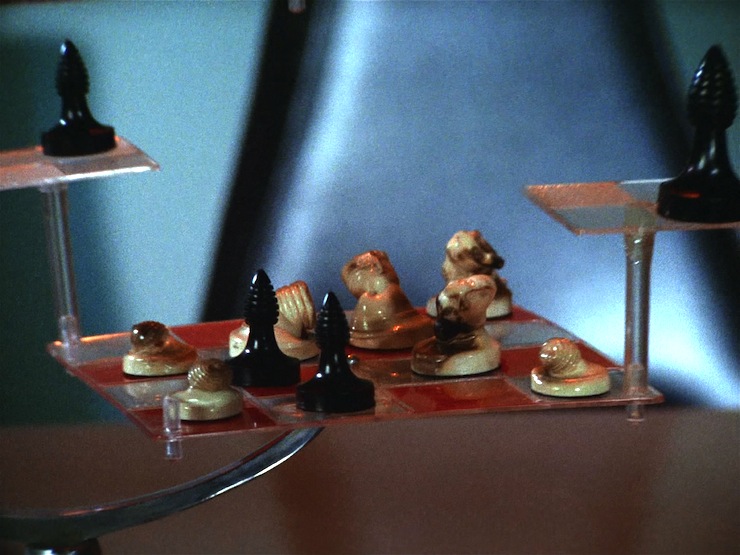
Rand tries to introduce Charlie to Yeoman Third Class Tina Lawton, who is apparently also seventeen years old. But Charlie blows her off because he’s totally smitten with Rand. Rand goes to Kirk—he says he talked to her about the ass-slap, but she says that isn’t it. She doesn’t want to reject him completely because it’ll hurt him, but she can’t follow through on his pass, either. Kirk promises to talk to him. When Charlie comes to Kirk’s quarters, first he asks about the melted chess pieces, then he tries to talk to her about Rand. First he says he won’t swat her ass again, but Kirk says that isn’t it. He tells Charlie that there are a million things he can have and a million things he can’t, and Rand is one of the things he can’t. Charlie doesn’t know how to live with things he can’t have, which Kirk mistakes for adolescent angst.
Kirk takes Charlie to the rec room to show him some martial arts falls and throws and such. (Kirk is, of course, shirtless, while everyone else is wearing a gi top.) Kirk demonstrates some throws with a guy named Sam, and when Kirk tries it with Charlie, and Charlie falls down, Sam starts laughing. Charlie’s eyes go white, and Sam disappears. Kirk immediately calls security and confines Charlie to quarters. But Charlie doesn’t want to go, and knocks the guards over and makes one’s phaser disappear—although we soon find out that all the ship’s phasers have disappeared. He agrees to go, barely.
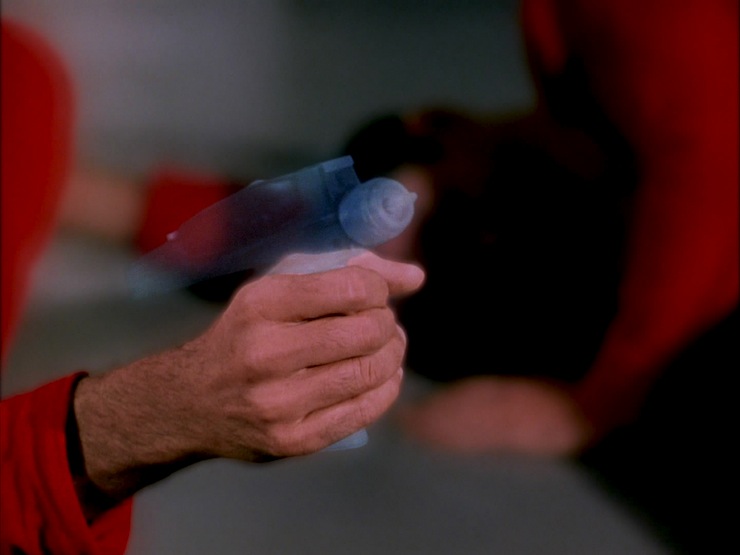
Spock mentions that some legends state that the Thasians can transmute matter and make things invisible—powers Charlie seems to be exhibiting. Kirk summons Charlie and asks if he was responsible for the Antares’s destruction. He admits to it, and his reason is that they didn’t like him. He then sabotages Uhura’s console and stops the Enterprise from changing course away from the colony they’re taking Charlie to. He wants to go where there are more people he can play with. Charlie makes Spock recite poetry a lot, but Kirk makes him back down—for now. He then turns Lawton into an iguana and barges into Rand’s quarters. Rand manages to open a channel to the bridge, prompting Kirk and Spock to try to rescue her. When he throws them into the wall, Rand slaps him, and he makes her disappear as well.
He only doesn’t make Kirk and Spock disappear because he needs them to run the Enterprise—it’s far more complicated than the Antares and he hasn’t figured it out yet. Kirk and Spock try to trick him into the brig, but that doesn’t work for more than half a second. He wanders about the ship, turning one woman old and making another woman’s face disappear before returning to the bridge, putting the ship on course for the colony and locking out communications.
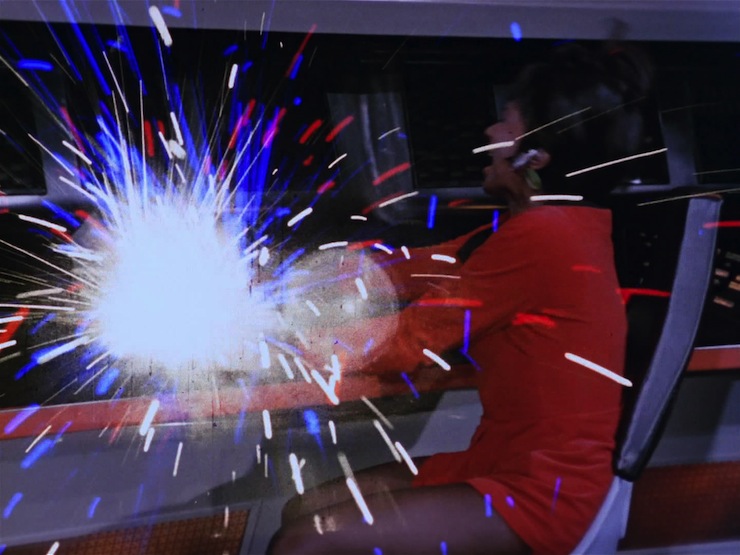
Kirk hopes that maybe if they turn everything on the ship on high, it’ll so completely distract him that Kirk can mess with him and McCoy give him a tranquilizer. The attempt almost works—but then the navigation console and communications clear and they discover a ship off the starboard bow that claims to be from Thasus.
Charlie begs the crew not to let them take him away, even as Rand is suddenly restored to the bridge (though still in her civvies). A Thasian big giant head appears on the bridge, claiming to have restored everyone (though they couldn’t save the Antares, as Charlie made a warp baffle plate disappear—they can restore that, but the ship will still be debris from the resultant explosion). Kirk tries to get the Thasian to let Charlie stay with them, saying they can train him, but the Thasian insists that they are the only ones who can take care of him, since they gave him his powers so he could survive.
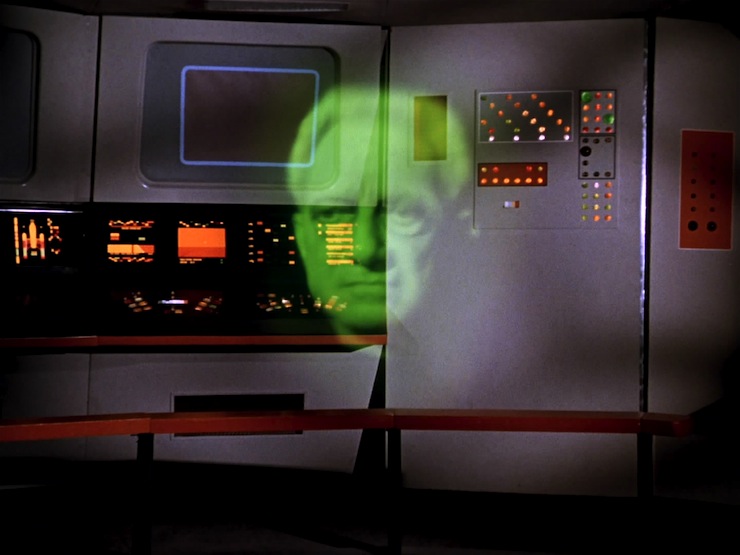
Scared to death of going back, Charlie begs some more, pleading not to go back, as the Thasians have no substance, they can’t love. But the Thasians take him away, and their ship buggers off, leaving a very saddened crew behind.
Can’t we just reverse the polarity? Apparently the Antares had a defective baffle plate that would’ve malfunctioned before too long anyhow. At least that’s what Charlie says.
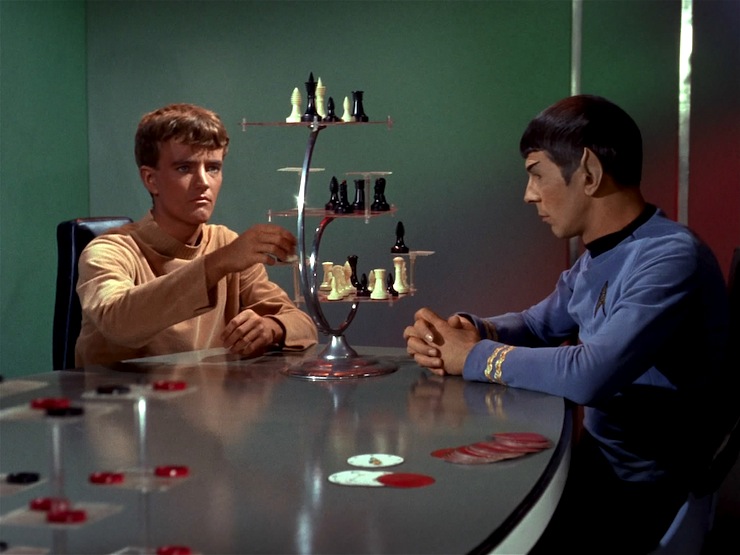
Fascinating. Not a banner day for Spock. He leaves an adolescent alone with a chess set after whipping his ass, gets his lyre messed with, gets his legs broken, gets made fun of by Uhura in the rec room, and is forced to recite poetry on the bridge.
I’m a doctor not an escalator. Kirk tries to get McCoy to be Charlie’s father figure, apparently having missed the memo that he’s the star of the show. McCoy insists that Kirk is better suited to it (McCoy’s more the weird uncle type anyhow…).

Hailing frequencies open. Uhura proves herself an excellent extemporaneous singer, coming up with lyrics on the spot to tease both Spock and Charlie in the rec room, which are done to the tune of the Robert Burns folk song “Charlie, He’s My Darling.”
No sex, please, we’re Starfleet. The mess hall scene when Uhura sings along with Spock’s Vulcan lyre playing is Exhibit B in the evidence that Roberto Orci and Alex Kurtzman did not pull the Spock-Uhura romance out of their asses for the 2009 Star Trek and Star Trek Into Darkness. I can see the pair of them rewatching the original series and getting to this scene.
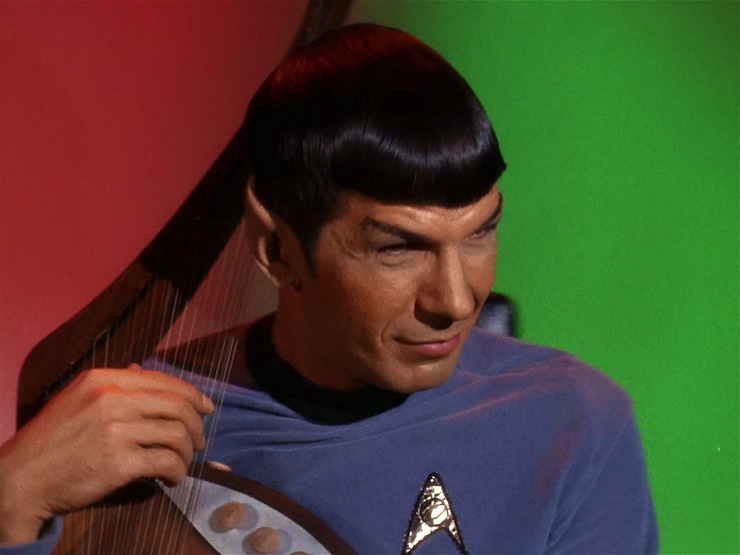
KURTZMAN (not a Trek fan, pauses after Uhura’s done singing): So, those two are fucking, right?
ORCI (a longtime Trek fan): Of course not. What are you, nuts? Spock would never…
KURTZMAN: Seriously? They’re totally fucking. I mean, it’s 1966, so they can only show so much, but still. Watch the scene again.
ORCI (yanks the remote out of Kurtzman’s hands and rewinds, then watches the scene again): Holy shit, they totally are!
Oh, and Charlie crushes on Rand, which is only a problem insofar as she’s an adult, he’s a teenager, and he’s all powerful.
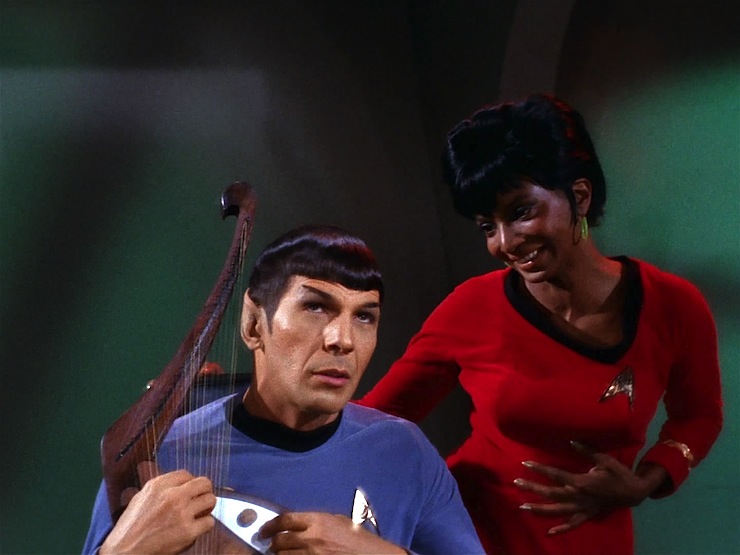
Channel open. “Oh, on the starship Enterprise
There’s someone who’s in Satan’s guise
Whose devil ears and devil eyes
Could rip your heart from you.
At first, his look could hypnotize
And then his touch would barbarize
His alien love could victimize
And rip your heart from you.
And that’s why female astronauts,
Oh, very female astronauts
Wait terrified and overwrought
To find what he will do.
Oh, girls in space, be wary, be wary, be wary,
Girls in space, be wary.
We know not what he’ll do.”
Uhura being a Spock-tease.
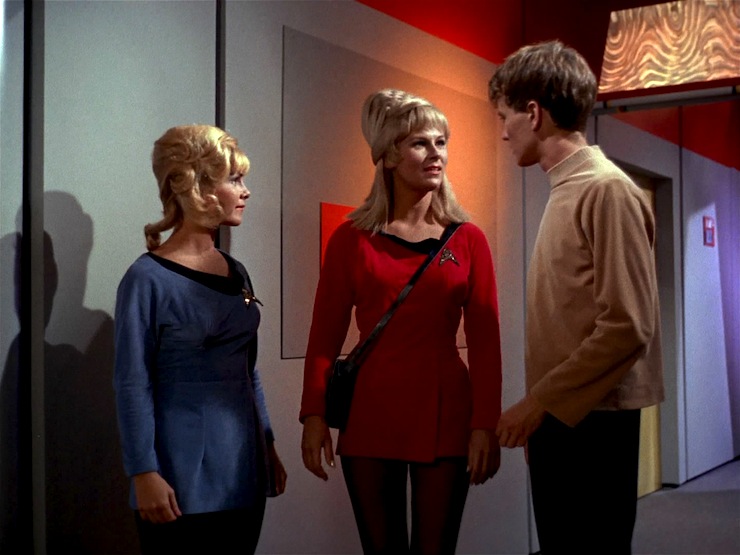
Welcome aboard. Charles J. Stewart and Dallas Mitchell play the ill-fated Stepford crew of the Antares, while Don Eitner, Patricia McNulty, John Bellah, Garland Thompson, and Bobby Herron play assorted Enterprise crew. Abraham Sofaer plays the Thasian; he’ll lend his impressive vocal talents to the Melkotian in “Spectre of the Gun” in season 3. Plus we get recurring regulars DeForest Kelley, Nichelle Nichols, and Grace Lee Whitney, and Gene Roddenberry provides his sole acting role on the show by doing the uncredited voice of the galley chef.
But the big guest is Robert Walker, who puts in an amazing performance as Charlie. According to Whitney’s autobiography, he refused to speak to the other actors on set, as he wanted to be isolated from them in order to make his alien-ness more real.
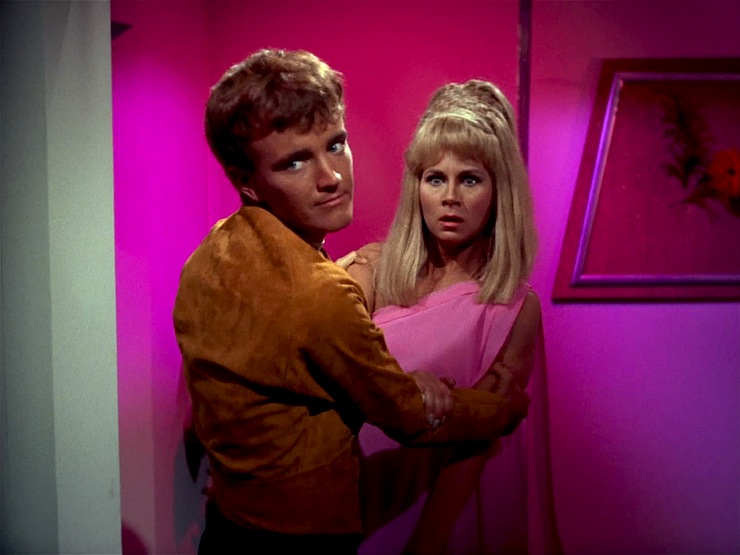
Trivial matters: Originally, this episode was to air later, as all the action took place on the Enterprise, but because of that, it had minimal post-production work, so it was ready sooner than some of the others.
The episode’s director, Lawrence Dobkin, will later appear on TNG as the Klingon Ambassador Kell in the episode “The Mind’s Eye.”
Starfleet is stated in this episode to be part of UESPA, the United Earth Space Probe Agency, which will be mentioned again in “Tomorrow is Yesterday,” and several times on Enterprise. The notion of the United Federation of Planets hadn’t yet been worked out…
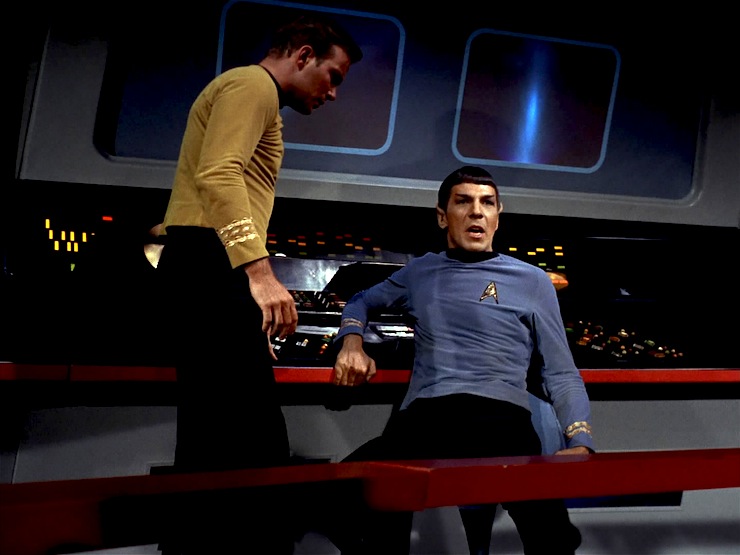
Charlie forces Spock to quote both Edgar Allan Poe’s poem “The Raven” and William Blake’s poem “The Tyger” which is part of Songs of Experience, as well as another poem that has the line “Saturn rings around my head, down a road that’s Martian red.”
The crew of the Antares are wearing the turtleneck uniforms from “The Cage” and “Where No Man Has Gone Before.”
The original title for this was “Charlie’s Law,” which was the title used for James Blish’s prose adaptation in Star Trek 1.
Sam was identified in Blish’s adaptation as Sam Ellis, a part of McCoy’s medical staff. In his Errand of Vengeance trilogy, Kevin Ryan fleshed him out as Sam Fuller, a part of the security staff.
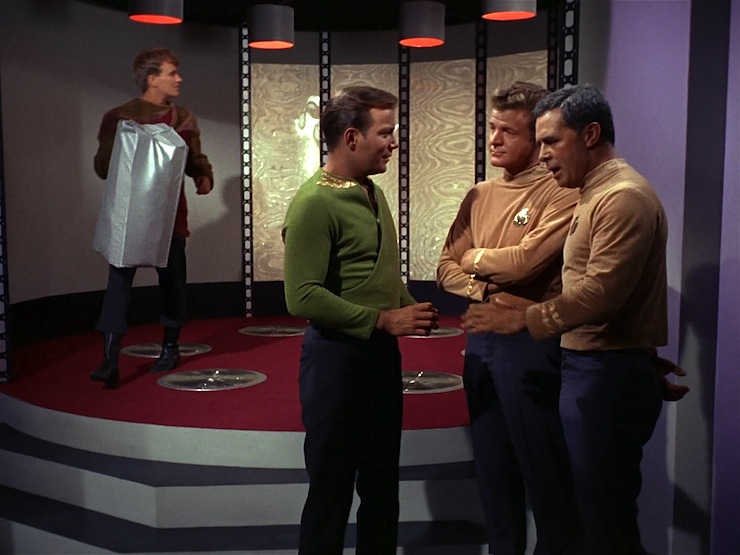
The script called for the Antares to be seen, but the earlier airdate made that impossible—all the exterior shots in this episode are recycled from “The Cage” and “Where No Man Has Gone Before.” The 2007 remastering included a shot of the Enterprise alongside the Antares, and also redesigned the Thasian ship as something slightly more sophisticated than a ball of light.
Spock’s Vulcan lyre—which was dubbed the ka’athyra in Margaret Wander Bonanno’s Dwellers in the Crucible, a term that has been used by many tie-in writers since—will also be seen in “The Conscience of the King” and “Amok Time,” among other places. Tuvok will be seen to play it in several episodes of Voyager as well.

To boldly go. “I want to stay!” It’s funny that this episode was chosen to air second due to its status as a bottle show, because it’s really an excellent choice. While “The Man Trap” lured viewers into a false sense of security with its scary monster, with “Charlie X” we get a prototypical Star Trek episode.
Charlie comes across as a bad guy, straight out of a Twilight Zone or Outer Limits episode, using his Thasian-given powers to wreak havoc. As the episode progresses, he becomes more and more awful, going from naïve to petulant to cruel. Robert Walker does superb work here, playing him as a true adolescent. Kirk’s line about how he’s going through what every seventeen-year-old goes through rings true in Walker’s performance, as he has the narcissism, the confusion, the raging hormones—with the added bonus of super powers that relieve him of having to actually be responsible or accept consequences. The powers are nicely understated, too—no fancy effects (or cheesy ones), just people disappearing or suddenly being iguanas or suddenly being old or suddenly not having a face—which makes the horror that much greater.
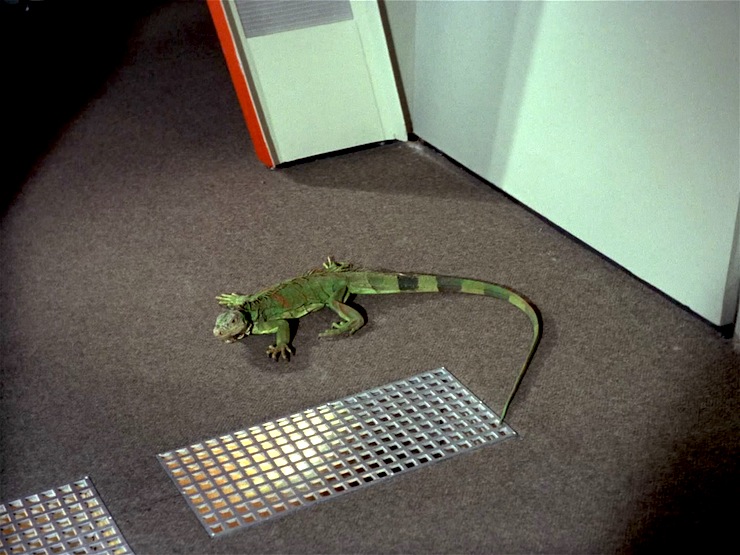
But what makes the episode work, what separates Trek from the straight-up monster-of-the-week that was a staple of genre television up to this point, is the ending. Even though Charlie has made people disappear, turned them into iguanas, removed faces, murdered twenty people, he’s at his heart a teenaged boy who just wants to be around people he can love. He is utterly unequipped to be that, but his begging and pleading not to let the Thasians take him away is so plaintive, so heartbreaking, that the very same Jim Kirk who tried to trick him and throw him in the brig and was half a step from hauling off and belting him, now becomes his advocate. Sure, we tried everything and have failed utterly, but we can train him!
Ultimately, however, there’s nothing to be done. Charlie has proven rather conclusively that he can’t live in human society—the twenty people he killed is testament to that—and they probably don’t have the means to stop the Thasians in any case. But he’s still a little boy who just wants people to like him. He doesn’t know any better—and his powers mean he probably never will.

What starts out as a horror story turns into a tragedy, and it’s brilliantly realized. The conventions of 1966 television are such that Rand is the only one to break into tears at the end, but I can’t imagine she was the only one.
Once again, we see the wonderful camaraderie on the Enterprise, mostly in the rec room scene as Uhura and Spock perform, though my favorite is Rand goading Uhura on with just a facial expression. And I particularly love Leonard Nimoy’s layered performance as Spock cycling through being aghast, amused, confused, and back again as Uhura serenades him.
Ultimately, though, what makes this episode work is Walker’s tremendous acting, making Charlie at once an incredibly complicated and incredibly simple character. We feel sorry for him even as we fear him, and even as we hate what he has done we are saddened by his fate. Just a bravura performance.
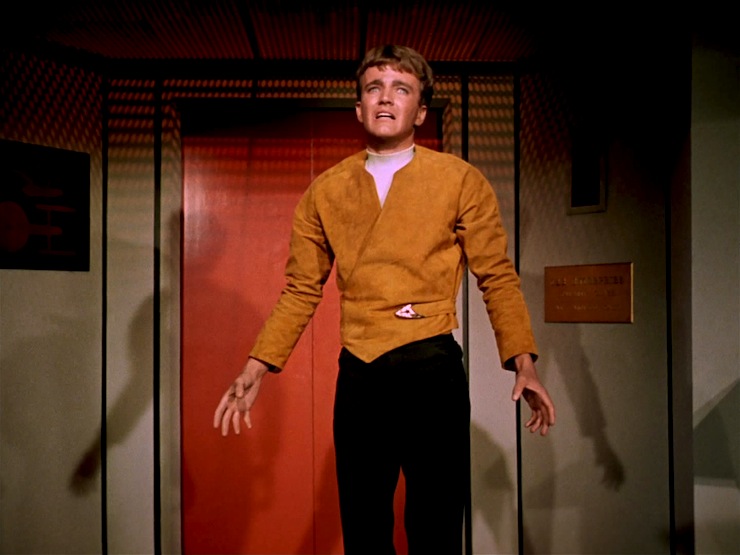
Warp factor rating: 9
Next week: “Balance of Terror”
Keith R.A. DeCandido will be a guest at Treklanta in Atlanta, Georgia this coming weekend, from the 24th to the 26th of April, alongside Trek actor Sean Kenney, Battlestar Galactica’s Anne Lockhart, Babylon 5’s Jason Carter, and Axanar’s Alec Peters, among many other nifty writer, actor, artist, and performing guests. Keith will have a table, will be doing a one-hour Q&A Saturday at 10am, and will be part of the Miss Klingon Empire Pageant and Independent Star Trek Fan Film Awards ceremonies.













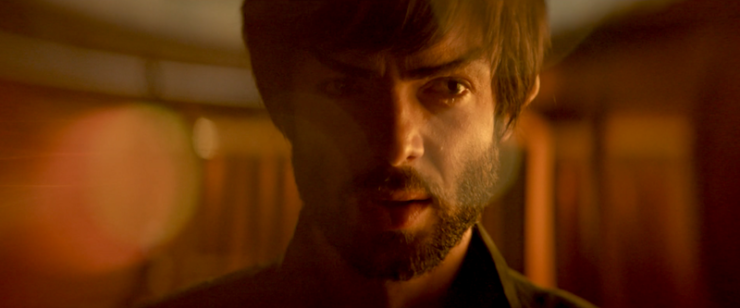

9?! I know, I know. The rating is the least important part of the rewatch review but I can’t help being surprised. This is one of the enjoyable episodes of TOS in my opinion.
I’ve always found TOS a little bit difficult to watch but this one takes the cake for me. It’s irritating to watch. Charlie is the worst and because you can’t really disassociate the rest of the episode from him, the rest suffers for it.
This is one of my favourite episodes of the original series. Everything Keith said; we are in total agreement. This story is powerful and heart-breaking. Charlie definitely left an impression on me.
One of my favorite things about this episode is Spock’s calm “My legs. They are broken.” Anybody else might be howling in pain, but Spock is pretty calm about it, which is some nifty insight, considering we’re still pretty early in the show.
A bit puzzling to me, though, is Charlie’s implication that Rand is the only “real woman” on the ship. He says all the other female crewmembers are just girls. What about Uhura?
Robert Walker can roll his eyes disturbingly far back in his head, man. But that is the absolute least of his performance, which, as you note, is what totally makes this episode. His cries at the end were downright haunting.
The reason I didn’t give the episode a 10 is because of some rather unfortunate pacing problems. This is a rare case where the syndication edits actually helped — the episode I watched on WPIX Channel 11 in New York as a kid growing up was actually much tighter than the one I watched on DVD yesterday, in which the third act went on just a bit too long.
—Keith R.A. DeCandido
Yup, this is one of the first season’s most memorable episodes, thanks to D.C. Fontana’s sensitive script, Robert Walker’s performance, and not a little bit to Fred Steiner’s strong musical score, which was heavily tracked as stock music throughout the season and had elements reused in later original Steiner scores like “By Any Other Name.”
But it’s kind of repetitive too, because we just saw this same “absolute power corrupts” idea explored not too long ago with Gary Mitchell in “Where No Man Has Gone Before” — and viewers in 1966 saw WNMHGB the week after “Charlie X,” so they got it twice in a row. I can see why TOS went to the mind-powers well so often; it’s a cheap special effect to have one actor gesture or roll his eyes and another actor mime being flung across the room or rendered unable to speak, and otherwise you can just make things appear or disappear with simple optical dissolves or jump cuts. But it does become kind of a tireworn trope over the course of the series.
Of course, “Charlie X” also treads much the same ground as the Jerome Bixby story “It’s a Good Life,” best known from its Twilight Zone adaptation with Billy Mumy sending people to the cornfield. That one was rather less sympathetic to its antagonist, though.
Still, it’s hard to deny that “Charlie X” is a better exploration of the trope than “Where No Man,” because of the added poignancy that this is happening because Charlie is an orphaned teenage boy who’s never had to learn to manage his power. Gary just plain went bad; Charlie didn’t even understand what good and bad were. He wasn’t driven to insane ambition by being granted godlike power; the power was everyday reality to him, but he’d never had to interact with other people before, and the very “gift” the Thasians had given him to let him survive proved to be a curse that doomed him to a life of solitude.
Damn, that’s sad. It’s interesting that you call this a prototypical Trek episode, because Trek has a reputation for being upbeat, and this is as tragic and devastating as ’60s TV ever got.
Charlie Evans returned in issue 8 of Marvel’s Starfleet Academy comic, still an ageless teenager more than a century after the episode. It was kind of a rehash of the same premise of Charlie being “rescued” and wreaking havoc, but this time we got to see the “pocket universe” he sent people to, which was your typical surreal comic-book alternate dimension. As far as I can recall, that’s the only time Charlie or the Thasians have been revisited in tie-ins.
@3/MeredithP: A boy with a crush is not the most objective assessor of female beauty. He tends to see the object of his crush as infinitely more desirable than any other woman.
Besides, Charlie has never had the experience of not getting what he wants. Rand was the first woman he saw, thus the first one he wanted, and he expected to have that desire fulfilled. He couldn’t comprehend rejection or failure or settling for alternatives. He would’ve had to look away from Rand before he could notice other women, and he just didn’t know how to do that.
I confess: the faceless woman scared the heck out of me as a kid!
Picking up on Christopher’s comment about Trek having an “upbeat” reputation, people tend to forget just how dark TOS could get. Yes, the basic premise is optimistic in that humanity has gotten its act together, hasn’t destroyed itself, and is exploring the stars, but TOS was not averse to horror and tragedy. The Final Frontier was a dangerous place where bad things happened, not some rose-tinted utopia.
Heck, many of the early eps end on somber notes: “The Cage” (poor Vina!), “Where No Man Has Gone Before,” “Mantrap,” “Charlie X,” “The Conscience of the King,” “Balance of Terror,” and, of course, “City on the Edge of Forever.” None of those can really be said to have happy endings, even if (most) of the crew and the ship survive.
@5 Charlie may not have appeared in any of the official tie-ins, but the character recurred in the fan film “Of God and Men,” unless my memory is mistaken.
@6: The faceless woman is the most scary thing I’ve seen in all of TOS. And I wonder if the Thasians actually saved her when they “restored everyone”, because how would she breathe? Shouldn’t she have suffocated by then?
On a lighter note, Kirk is not the only one who’s shirtless in the gym – there are two shirtless guys in the background fighting with sticks.
@4/krad – Re: “syndication edits” and “Charlie X” – I grew up watching a version that trimmed the initial butt-slap that sets the plot in motion, and didn’t see it until about 10 years ago when the series was released on DVD. In my head, I kept thinking McCoy had swatted Charlie on his rump to send him on his way after his physical exam; I would have sworn to it had someone asked me! How funny our minds are, filling in the gaps for us.
I agree with Keith’s write-up in every regard. I’ve always liked this episode and now, having read his summary and analysis, I like it even better. And Christopher’s response about Charlie’s assessment of the women aboard Enterprise is on the money. When you’re a teen with a crush, you’ve got eyes for no one else.
I did always think people should have freaked out a lot earlier, when Charlie summons up the publicity-photo playing cards of Rand. I mean, doing a card trick via sleight of hand is one thing; but those pictures come out of nowhere! Of course, the Enterprise crew is used to automated surveillance footage that looks like it’s been professionally edited for network television, so…!
Great episode, and also Grace Lee Whitney’s finest work as Rand in the limited time she was around. I wish she’d been able to “stay, stay, stay,” as well.
@6/GregCox2 and @9/Jana – I join your “scared by the faceless woman” club. I also used to think, because of the way the show was edited, that after Charlie turned Tina into the lizard, he further turned her into the rose he presents to Janice! Probably not. (But he could’ve if he’d wanted to, I guess!)
Count me in on the terrified-by-the-faceless-woman club too. I don’t care how much effects have moved on since the 1960s, that is still the scariest effect I ever saw.
Yeah, 2nd Tech. AJ Rimmer did a rubbish job repairing it.
I seem to remember reading somewhere that the concept behind this episode was that Charlie was an alternate version of Valentine Michael Smith from A Stranger in a Strange Land by Robert Heinlein. Instead of a wise and benevolent superman, they said what if he wasn’t so nice?
Reading Keith’s review of this episode did make me think of Stranger in a Strange Land – the story told from the perspective of the city government. Superman who keeps making your police officers disappear and has no regard for social conventions or laws.
The difference is in the ending, where instead of killing him, the “authority” still want to try and help him.
Anakin in “Attack of the Clones” always reminded me a little bit of Charlie here.
I’m with @1 — regardless of acting quality, this episode was just plain unsatisfying for me. Perhaps I was just too hungry for character development of the main characters, while (as we’ve discussed earlier in this Rewatch) 60’s TV tended to have the guest-of-the-week (Charlie here) get the important developments.
has anyone tried to tie Charlie X and the Thasians in with the Q continuum? just wondering…
it is interesting how many beings there are in Star Trek that are far and away more advanced than the human and human-like friends/enemies (these guys, Q, the traveler, that old guy and his wife alone on the devestated planet in TNG, etc), and aside from Q, they all seem to want to be left alone. is this ever explored?
@17/FSS: Oh, please, no. I really dislike the tendency to try to lump two similar races together. It’s a huge, huge universe, so there should be lots of different species out there, not just the same few ones over and over.
And if you think about it, given that the universe is thirteen and a half billion years old while humans are only a few hundred thousand years old, it follows that races on the level of humanity must be enormously outnumbered by far more ancient and advanced races. So trying to lump all the superadvanced aliens into the same species is getting it backward.
@18 – LOL – fine. no worries.
Anoother great write up!!! Kudos.
When I first saw this in syndication in the 70’s Charlie reminded me of too many spoilt brat classmates — I would have been in grade three or four at the time. I hated them all and so this episode, which is mostly well written and well realized, always had a certain distaste for me. On one level I genuinely sympathised with the kid as it wasn’t his fault he was a massive ass hat. On pretty much all the other levels I wanted to kick him in the balls soooo hard. As a result I usually avoid this one.
Still, it was more complex storytelling than I got anywhere else at the time (Emergency, Adam-12, Batman, Gilligan’s Island, etc.) and that was always great. The TV shows kids watch today (I know ST wasn’t a kids show) are overly simplistic, moralistic and generally annoying. I was lucky to grow up with TV that was a little more mentally and emotionally stimulating.
@20/Al3x: I don’t know what your baseline is for “the TV shows kids watch today,” since there are a lot of “kid’s shows” out there that are deeper, richer, and more sophisticated than the shows I watched growing up. For instance, Avatar: The Last Airbender and The Legend of Korra are children’s shows that are among the best TV shows of any genre or age category produced in the past decade, and have major adult followings as well.
And if anything, the kids’ shows today are a lot less moralistic than the ones I grew up with. Generally they seem to be more about irreverence and snark than wholesome lessons. There’s certainly a lot more violence in something like the current Teenage Mutant Ninja Turtles cartoon (which is brilliant) or Power Rangers — or Avatar/Korra — than there was in the shows of my childhood like Fat Albert and Isis and Scooby-Doo. So I really have no idea what modern kids’ shows you’re talking about here.
In the comments under the cartoon “Charlie X” in Planet of Hats, David Morgan-Mar notes that the script mentions that the cook has been asked to make a special meal because “it’s Thanksgiving back on Earth.” He jokes, “I guess by the 23rd century, cultural assimilation has progressed so far that everyone on Earth (and in space) celebrates American holidays.” But here’s my trivia question: Are there any other times in ST TV series or movies where it is indicated that a human traditional holiday of any kind is being celebrated? Of course, many trad holidays have a religious aura, which would lead Roddenberry to hope we would outgrow them, I suspect.
@22: What if they were talking about Canadian Thanksgiving?
@17/18: I’m not a fan of the way that people always try to lump Trelane’s race with the Q, either. I mean, there’s a similarity in powers and behavior, but there are also differences too. Especially since TNG tried to paint our Q as a bit of a renegade. It just always felt a little short-sighted to me when there was really no stronger implication that they were the same race.
@22/Saavik: In “Generations”, Picard celebrates Christmas with his imaginary family in the Nexus.
I’ve got a question of my own: In the German translation of “Charlie X”, Thanksgiving got replaced by Easter, and instead of turkeys, Kirk orders coloured eggs from the kitchen. Has anyone else watched the episode in a different language, and if so, how is this scene translated?
In “Dagger of the Mind,” which should be coming up soon, we got a brief flashback and/or fantasy based partly on a memory of Kirk bringing Helen Noel to either his cabin or her cabin after a Christmas party.
Just wanted to add that I found this to be one of the more re-watchable of the TOS shows (and I’m really more of a fan of later ST filmed efforts, TBH, so that does say something). Because it does not require a lot of post effect works, it can be watched, as I first did, in the recent past, versus as a child and it holds up really well against dramatic SF, so I would say that a “9” is probably merited, particularly for the performance, especially the nuances others have pointed out here.
It’s really a shame Robert Walker did not have much of a career as an actor other than as a bit player/character/non-lead, past the ’60s, and really no lead roles when he was most active in that decade.
Such a creepy episode! Didn’t think Charlie looked 17.
@27/Danis: Robert Walker, Jr. was 26 at the time. But then, most teenage characters in TV and movies are played by actors in their 20s. Sometimes it gets pretty ridiculous. There’s an episode of the George Reeves Adventures of Superman series called “The Boy Who Hated Superman,” and the “boy” was played by an actor who was nearly 30. It was deeply incongruous watching him pretend to be a teenager. Although it was almost as bad with Jack Larson as Jimmy Olsen.
@21 Christopher: The sheer weight of programming available today is orders of magnitude greater than the stuff available in the 70’s when I was a kid, so I’m certainly not about to provide a list. I will, however say that I have a nine-year-old daughter and spend a tremendous amount of time watching TV with her and scanning through Common Sense Media for appropriate proagramming. She was into Pokemon for a mercifully brief period and has enjoyed several other shows. Most of the stuff we find these days is shockingly simplistic — and by that I mean downright stupid. Henry Danger is tons of fun, but it’s really quite terrible television. I’m not going to comment on the shows you mentioned. Suffice it to say that either you and I do not share an aesthetic sense or we have different concepts of “sophisticated storytelling.”
My comment was about the fact that Star Trek was one of the first shows that provided nuanced and layered stories that kids could watch and that helped my appreciation of storytelling evolve beyond what was typically on offer. And indeed, that same lowest-common-denomiator shit is still dominating TV Guides today. (Reality TV is, without a doubt, one of the seven signs of the apocalypse.) I’m not talking about the adult programming here. A lot of the stuff that’s on after 9 pm or on specialty cable networks like 19-2, Game of Thrones, Grimm, et al., are much more sophisticated than their equivalencies from the 70’s, 80’s and 90’s. (The 19-2 episode “School” is probably the best hour of TV produced in the last 10 years.) But ST: TOS was undeniably kid friendly and that changed my life. Characters had more depth, plots were more complicated and the structure of the stories themseves less formulaic. There really isn’t much out there doing the same thing today.
@27/Danis & @28/Christopher – I actually did okay suspending my disbelief on Walker’s age. He’s obviously a bit older than 17, because actors often play younger, but I found his face fairly youthful and could believe his age.
Actually, Tobey Maguire was in the exact same situation – 26 playing 17 – for Spider-Man, and I find him much less believable. There’s something about Robert Walker’s face and mannerisms that made it work for me.
Hey krad, shouldn’t you be saying “hi” to DC Fontana as a new face in your “welcome aboard” section? ;)
I’ve always enjoyed this episode, and I didn’t remember Blish’s version using the older title, it’s been so long since I read it… Although I do agree with Chris that it was a little repetitive along with “Where No Man…”; regardless of the airing order, two episodes with basically the same plot in the same season? But of course, Charlie X is the better episode, for numerous reasons, not only because of Charlie not knowing good from bad, but because it was filmed after, and the cast knows their characters better.
Chris beat me to the comic appearance of Charlie Evans. For once I felt like I was adding somethign to the review. :)
Also, so an underage Yeoman? I didn’t remember that… makes wunderkind nuTrek Chekov not so strange.
@13 – Dolthon: I had never considered that, but it’s an interesting idea.
@18 – Chris: I don’t like them lumping all omnipotent aliens with Q, but I did like retconing Trelane into one.
@27/28: If you guys are creeped out by older actors playing teenagers, be glad you’ve never watched Mexican comedy shows, which love having adults play children, complete with short pants, fake freckles, and oversized lollipops.
I wasn’t a fan of Charlie X back when I first saw it. I used to feel it reeked of clichés, namely the childish teen plot device. Time has been kind to this one, as I warmed up to it. It doesn’t feel nearly as pedantic, and it’s actually pretty well performed and executed. A lot of it owes to Walker’s performance, obviously.
There is one thing I still don’t like about this episode though, and it’s his eyes. Feels like a really cheap visual way of conveying his anger and power.
Definitely one of this episode’s highlights is the way the crew tries really hard to make Charlie at ease on the ship. And the ending more than pays off. Everyone feels bad for failing him. If anything this would have worked even better as a TNG episode. Rand wouldn’t been the only one crying. Everyone would have felt for him.
Nevertheless, Fontana’s script really hits the right notes, addressing the power corrupts angle in a way even the second pilot couldn’t, since in this case you can connect with the boy’s inner struggle unlike Mitchell’s power rush. Very Trekkian, with a very honest portrayal of the crew’s daily life.
The day I saw Trek 09 in theatres, my mind flashed back to this episode instantly, as I recalled Uhura and Spock’s relationship. I always felt it was a natural attraction thanks in no small part to this episode’s scene.
@32: El Chavo del Ocho has been a hit on Brazilian television for decades pretty much because of this ridiculous portrayal of children by grown men.
@33/Eduardo – Actually, about the eyes…Keith described it three times as Charlie making his eyes “go white” – which is just a really, really heavy eye-roll by Walker. And I think that is cheesy, yes. Obviously it’s cheaper than actually doing an effect, even the silver eyes from “Where No Man Has Gone Before,” but it just looks silly. If they’d done some kind of effect, it might have been more…effective? (I’ll show myself out.)
By the way, since @22/Saavik mentioned the “Planet of Hats” comic, I love one of its lines for this episode: “Don’t worry, Yeoman. I’ll have the awkward man to psychotic man-child talk with him.”
Daniel Kukwa: Huh? The “Welcome aboard” section is for guest stars, not writers…..
—Keith R.A. DeCandido
I don’t agree that some kind of special effect would’ve been better than Walker’s eye roll. I think it would’ve been a lot cheesier, and nowhere near as creepy. The simplicity of the effects makes them more potent than some flashy energy-glow animation or something.
Besides, the characters are supposed to take a while to figure out that Charlie has superpowers. They would’ve had to be pretty dense to avoid noticing his eyes glowing or whatever.
@33 – Eduardo: I know, it’s also a big hit in Uruguay… but more because it’s funny. We don’t do any similar shows here, and as far as I’ve seen in Brazil, you guys don’t, or at least it’s not a regular thing. In Mexico, they do it all the time in all manners of comedy shows.
This is why Key & Peele had to do those PSAs about slap-ass.
Thlap-aaaaath…
Love the 3rd Rock ref!
As for adults playing teenagers, that’s always been fairly common. Mickey Rooney played teen characters well into his 20s as did Michael J. Fox a few decades later. I think the only real teens who were regulars on “Happy Days” were Erin Moran and Scott Baio and that was only because they started the series as children. Sarah Hyland was 19 when she started playing Haley on “Modern Family” so technically a “teen” but legally an adult. With adult actors, you don’t have to follow all those pesky child labor laws.
Speaking of the ass slap, I found that very funny between the crewmembers. Not that it wouldn’t happen, but that they would show it.
@36/Christopher – Okay, then I would have preferred a long blink, or some other physical mannerism (see also Bewitched, I Dream of Jeannie), simply because I don’t like the exaggerated eye-roll. But this is being so hugely punctilious I’m annoying myself, so I will accept that it is what it is. *grins*
@41/Meredith: Now I’m imagining the “tinka-tinka-tink” and laugh track every time Charlie rolls his eyes…!
For the record, the eyerolls never bothered me. I especially like the one where he throws back his head at the same time. Darn creepy.
The eye rolls are effective because they almost suggest some kind of seizure when he uses his powers. The rolling back of the eyes is a symptom often associated with epileptic seizures, fainting, or the like. So it could be an indication that Charlie is entering some kind of altered mental state that puts a lot of strain on him.
@43/Christopher: Interesting take on it, but I don’t see it that way. Charlie uses his power exactly when he wants to, as he wants to. Seizures come upon people unexpectedly and involuntarily.
I also don’t sense the altered mental state is too much of a strain for him. Witness the multiple times he uses it walking down the corridors near the episode’s end, for instance. The only time the power becomes a great strain is when he’s using it to control the ship while Kirk and crew are turning on every system they can.
@44/MikePoteet: I never said they were seizures. That much is obvious. I just meant it suggests there’s something neurologically similar going on, some kind of alteration of mental state.
@45/Christopher: Well, you said “some kind of seiz-” — OW! Too literal, cannot complete pedantry. :D
I said “they almost suggest some kind of seizure.” I did not say “they are some kind of seizure.” If you take all my words literally, it’s clear what I was saying.
@27: Well, that certainly hasn’t changed. Teenagers are still usually played by adults in most TV shows and movies. TV Tropes even have a page called “Dawson casting” about this particular thing. Some adults are more physically believable as teenagers, some are really not. For instance, Alyson Hannigan was more believable on Buffy than Nicholas Brandon or Charisma Carpenter. Buffy, one of my all-time favorite shows, also always had a high school populated by students played by extras who looked about 35. Something similar is the case with the majority of teen shows. It’s far more remarkable to have an age appropriate actor, as Claire Danes and Devon Gummersall were on My So-Called Life (and MSCL was generally the most convincing in terms of casting, the other cast members who were older but played teenagers looked young enough to pass as teenagers). The above mentioned Game of Thrones is another example – in addition to aging up the characters compared to the book, older teenage characters like Daenerys, Jon Snow, Robb Stark, Gendry, are/were played by actors in their mid-20s, although younger characters like Bran, Arya and Sansa were cast more age appropriately. (Jojen Reed was played by a 20-something actor, but he looks so boyish that you’d never notice it.) And kudos to anyone who can figure out how old Tommen is supposed to be.
@33: Watching TOS, I thought Spock and Uhura had really great chemistry in these early episodes – it’s a pity that Nimoy and Nichols didn’t get to interact more (and that she generally didn’t get more lines in the show – and better lines than “Captain, I’m afraid”). I found it very odd that the early episodes played with their dynamic, and then it was just dropped – they barely ever interact later (though there are a few subtle moments, as in “Is There in Truth No Beauty?”). It made me wonder if someone at the network watched it and said: “All right… cut it out”. It was 1966, after all. TOS may have eventually had that famous interracial kiss between Kirk and Uhura in season 3 – but it only happened because the two characters were forced by aliens, while they really did not want to have anything sexual with each other; in terms of interracial relationships, a mixed message, at best.
@48/Annara: There’s at least one moment later in the series — I forget the episode off-hand — where Uhura is hard at work to repair a circuit in the communications console or somesuch task, and Spock, after some initial nagging of her, expresses (in his reserved Vulcan way) complete confidence in her ability to do it. I suppose a modern audience might see it as condescending, but the way Nichols plays her reaction, I think Uhura took it in the spirit in which it was intended. She seems delighted to have elicited this praise. That always seemed to me another piece of evidence that “prime” Spock and Uhura shared at least a great deal of affection for one another.
I’m forgetting their interaction in “Is There In Truth…” which is one of my favorite episodes – refresh my memory, please? Thanks!
@49/Mike: That’s in “Who mourns for Adonais” (my favourite scene in that episode). And he isn’t really nagging – he asks her to hurry up, she explains why she can’t, and then he assures her that she is the best person for the job.
Oh, and I don’t think it’s condescending at all. He simply tries to make up for rushing her (it seems that his social skills have improved since “The Galileo Seven”).
@50-51/Jana: Thanks! I couldn’t remember for the life of me. You’re right – it does also show his growth as a commanding officer. That’s part of Spock’s arc that often gets overlooked. I love the fact that he was a “teaching captain” by the time of ST II.
@49: The moment from “Is There In Truth No Beauty?” is ambiguous, because it’s Ambassador Kollos mind-melded with Spock, talking to Uhura. Spock mind-melds with Kollos and gives Kollos the chance to interact with others. Kollos has a warm, open personality, he smiles, feels delighted with everything he is seeing and learning, and he freely expresses feelings – whether those feelings come from him, or from Spock. Kollos/Spock warmly greets Kirk as “old friend”, recognizes and greets McCoy, and then recognizes and greets Uhura and starts quoting a line from Lord Byron’s famous love poem “She Walks in Beauty”:
“And Uhura, whose name means ‘freedom’. ‘She walks in beauty, like the night…’ ”
This provokes McCoy to tell Kirk: “That’s not Spock!”
Spock/Kollos turns around: “Are you surprised to find that I’ve read Byron, Doctor?”
McCoy: “That’s Spock!”
So, even the characters are confused where Kollos ends and Spock begins, or vice versa. But Kollos did not know Kirk, McCoy or Uhura previously, and he’s from a completely alien culture; not only had he certainly never read Byron, but he does not have human senses in his own form and previously didn’t even know what humanoids looked like. So, the things Kollos/Spock is expressing in that scene had to come mostly from Spock’s memories and feelings about the people in his life, even though Kollos expresses those feelings in the way Spock would not.
@53/Annara: That’s a beautiful interpretation of the scene!
@48 – Annara: I thought Joffrey was about 14-15 (I’ve only seen the show, not read the books), while Tommen was about 12… but he looked more like 14-15 in last night’s episode. I guess he grew up a bit, marriage and kinghood will do that to you… :P
(Highlight above for the rest of my comment.)
@55 – Lordmagnusen: Please keep the Game of Throne spoilers to yourself. I haven’t had a chance to watch any series 5 yet and was not expecting to come across spoilers for it in a Star Trek TOS rewatch. It’s not appreciated.
There are no spoilers in my post.
@MaGnUs: I’ve whited out part of your comment, just to play it 100% safe and avoid any further complaints from people who haven’t seen the show seen the latest episode(s) yet. The information in your post shouldn’t spoil the episode for anyone, but it’s also news to people who haven’t seen the last few episodes, so I’ll err on the side of caution for now.
In general: avoiding information and commentary (even not-particularly-spoiler-y information) about the series is difficult, especially online, and we can’t promise that people won’t bring up the show in unrelated threads on this site–it’s also fine for them to do so as long as they avoid major spoilers. We’ll do our best to white out spoilers if/when comments are flagged for moderation, and appreciate everyone’s cooperation, as always–thanks, all!
Understood, BMcGovern. I also loathe spoilers, and will never spoil something intentionally.
I know you’re all still scarred for life by the Woman With No Face, but Google has failed me, therefore I must fall to you: does anyone know how they made that makeup effect?
@60/Jeremy Marr: At the time, with no CGI, there was only one way they could’ve done it — just straight up stick a piece of rubber over the actress’s face. Looking at the screencap, it’s recognizably just a solid sheet of material with the woman’s nose pushing it outward a bit from behind.
If I had to guess, given the brevity of the shot, I’d say that the face piece and the wig were a stocking-mask sort of deal that could be quickly slipped on just before the shot, then quickly pulled off afterward so the performer could breathe. Or maybe there was some kind of snorkelish breathing tube built in and sticking out under the wig or something.
Bah. Spock and Uhura were shipmates who spent a lot of time working in proximity to each other. Hanky-panky was a no-go, because Spock is married at this point (well, “More than a betrothal, less than a marriage”. And in control of his emotions. And an affair between a superior (2nd in command) and subordinate is against the rules in the services upon which Roddenberry based Starfleet.
I can hear that Ensign by the turbolift doors bitching now- “Spock only talks her up because they are totally doing it”.
The Woman With No Face (that might have made a great Strange New Worlds story) puts me in mind of The Guy With No Eyes currently on Agents of S.H.I.E.L.D. He creeps me out in exactly the same way. Maybe that’s petty of me, but there you have it.
Not me, Mike, I’m a fan of The Question:
Ah, yes, The Question! I don’t find him creepy. But this guy on S.H.I.E.L.D. doesn’t just have no face, he’s got no face and a big bulge where his eyes ought to be, and they’ve done the makeup somehow so that it always looks kind of blurred as well as featureless… urgh.
But, no, The Question is cool.
@65/Mike: Well, Gordon has a featureless upper face, but he still has a nose and mouth. As for the blur, that might be CGI erasing the eye holes in his makeup. Although I’ve never really noticed it myself.
@66/Christopher: That makes sense. Some shots the blur seems there, sometimes it doesn’t. But it all makes it seem off somehow, which really only adds to the effect. So not a complaint, just an observation.
He doesn’t have a bulge, he just has no eye sockets. Also, I have not noticed the blur either.
@68/lordmagnusen: It could be that the perception of Gordon’s face being blurred is an artifact of the observer’s brain. We’re accustomed to looking at someone’s face and seeing their eyes constantly moving, so our brains expect motion there and maybe mentally stabilize the image of another person’s eyes so we can maintain focus on them; so when we see a face with no motion there, once filtered through the brain’s automatic stabilization thingy, it sort of creates a perception of negative motion, if you get what I mean. So it looks like there’s something changing there, and we interpret that as a shifting blur.
Or maybe there is a digital blur and I’m just overthinking it.
Yeah, that’s why I’m saying I can’t see it, and not that it’s not there.
I’m a little behind on my reading, so I’m reaching all the way back to Saavik’s comment @22:
“Are there any other times in ST TV series or movies where it is indicated that a human traditional holiday of any kind is being celebrated?”
I seem to recall – though I may be misremembering – that in TNG’s “Data’s Day,” Data makes a reference in his log to a celebration of the Hindu festival of Diwali that was taking place on board. But that’s the only other example I can think of off-hand. Of course, on DS9 it seemed like there was some kind of Bajoran religious festival every other week until the Dominion war started…
@71/Lance: Nice catch, Lance!
A bit late to the party here, but I wanted to add another example to the list of “kids being played by adults,” this one from within the Trek Family. In this case, Nog, from DS9.
I realize they never indicate an actual age for the character, but it’s intuited that he and Jake are at least peers. (Also, the Ferengi makeup is useful in disguising age.) All the same, I never would have guessed that Aron Eisenberg was nearly a decade older than Cirroc Lofton.
Charlie X is a great episode, but hard to watch because Charlie is both a tragic figure that earns our pity and at the same time he is incredibly selfish, unpleasant, immature and annoying (like most teenagers I guess). One thing that bothered me about this episode was that the leaders of the Antares were so eager to dump Charlie onto the Enterprise, knowing full well what kind of damage and destruction he is capable of! This is very bad behavior from one captain to another. I guess Ramart felt guilty later and tried to warn Kirk (but too late). This type of story (immature child with superpowers) was done in a more entertaining fashion in ‘Squire of Gothos’ where Trelane was more charismatic and even lovable.
@74/Palash: I think the idea was that Charlie was forcing/terrorizing the Antares crew into taking him to a bigger, better ship, and it wasn’t until after they were free of his influence that they thought it was safe to warn the Enterprise — though it turned out that his powers had greater range than they’d thought.
This episode wound up being really good, even though I was geared up to find yet another human-being-has-godlike-powers story unbearably tiresome.
I admit I thought of the Q a lot throughout the episode and figured connecting this episode to them in tie-in fiction was inevitable right up until the end when the aliens actually show up and don’t seem very Q-like at all. Part of that was due to this episode reminding me of “True Q,” if only superficially, but part of it is also that the sheer number of space god aliens in Trek irritates me, so combining a couple where possible is satisfying. It doesn’t work here in any case, and it was nice to see that these particular all-powerful aliens are at least flying around in a ship.
@76/Michael Booth: “the sheer number of space god aliens in Trek irritates me, so combining a couple where possible is satisfying.”
I see it the other way around. Given how much older the galaxy is than humanity, and given the Trek conceit that species eventually evolve to a “space god” level when they get old enough, then statistically speaking, there should be far more “space god” species in the galaxy than species at a humanlike level. Even if you assume that many species go extinct before reaching that stage, or just follow a different evolutionary path, there should simply be so very, very many ancient civilizations in the galaxy that there would still be a ton of “space gods” out there even if only a fraction of species made it to that level.
TOS did a much better job than later series of conveying that sense of a galaxy with a deep ancient history, a galaxy where only a handful of the civilizations we encounter are at our level and the majority are either vastly more ancient or still quite primitive. The later shows tend to assume that the majority of other species are within a few centuries of our level or at most a few millennia, which is statistically nonsensical and a failure of imagination.
This is a very minor part of this great episode, but it’s something that has always intrigued me. In the first scene when the Antares officers hand over Charlie, Kirk offers them some goodies, including “entertainment tapes.” I have long wondered just what constituted “entertainment” in the 23rd century? Obviously, based on other episodes, ballads and rock and roll music, as well as Shakespeare are still popular. But it’s unclear if they have movies – I mean, for people exploring the galaxy and discovering fantastic new planets and civilizations on a regular basis, would the very concept of “escapist” entertainment even be valid? And would “science fiction” have any meaning for them?
Also, as the reviewer Keith pointed out, Yeoman Third Class Tina Lawton is supposedly the same age as Charlie, which means she’s only… seventeen years old! Seventeen and already serving on a starship?? Was she a child prodigy who sailed through her classes at the Academy in record time? How can a mere teenager even be considered fit and prepared to undergo the rigors of deep space travel??
@79/Palash Ghosh: A yeoman is an enlisted crewmember and would not have attended the Academy. The present-day military allows anyone age 17 and up to enlist (though under 18 requires parental consent), and basic training for enlisted personnel takes only a few weeks. It’s like joining the workforce after high school. You only need to go to the Academy to become an officer, much as you need to go to college to earn a degree and get a better job with more responsibility.
@78 In some ways that’s like asking if science fiction has any meaning for us, who’ve seen spacecraft at least pass and sometimes land on every planet in the solar system, and carry devices rather more capable than Multivac in our pockets which also offer at will full video communication to pretty much anywhere. Experience suggests that living in a science fictional world doesn’t dull interest in science fiction.
That said, it’s true that Trek seems to deemphasize noninteractive mass entertainment in favor of small scale performances and later the holodeck. Which could certainly present elaborate shows for the crew to watch rather than participate in, but never actually gets used that way. No one seems to want to just watch anything bigger or more produced than a live Shakespeare play. For blockbusters, spy stories, mysteries, etc., being a participant seems to be the only way to go.
@78 & 81: I suggested in a couple of my Trek novels that 23rd- or 24th-century science fiction focuses largely on time travel and parallel universes, since those things aren’t as routine to the general public as space travel, aliens, teleportation, etc. and still seem like sci-fi (though Starfleet crews who star in TV series encounter them far more frequently).
As for escapism, they might prefer high fantasy, maybe. Although historical fiction has always been popular for escapism, and we know it’s still popular in the Federation — Picard’s Dixon Hill stories, Deanna’s Westerns, Janeway’s Gothic novel, etc.
“Saturn rings around my head, down a road that’s Martian red.”
Since I read “Stranger In A Strange Land” about the same time at 12, I have always assumed this was Roddenberry’s thoughts on the RAH book. Of course, this was before Manson, which really put a different light on the subject.